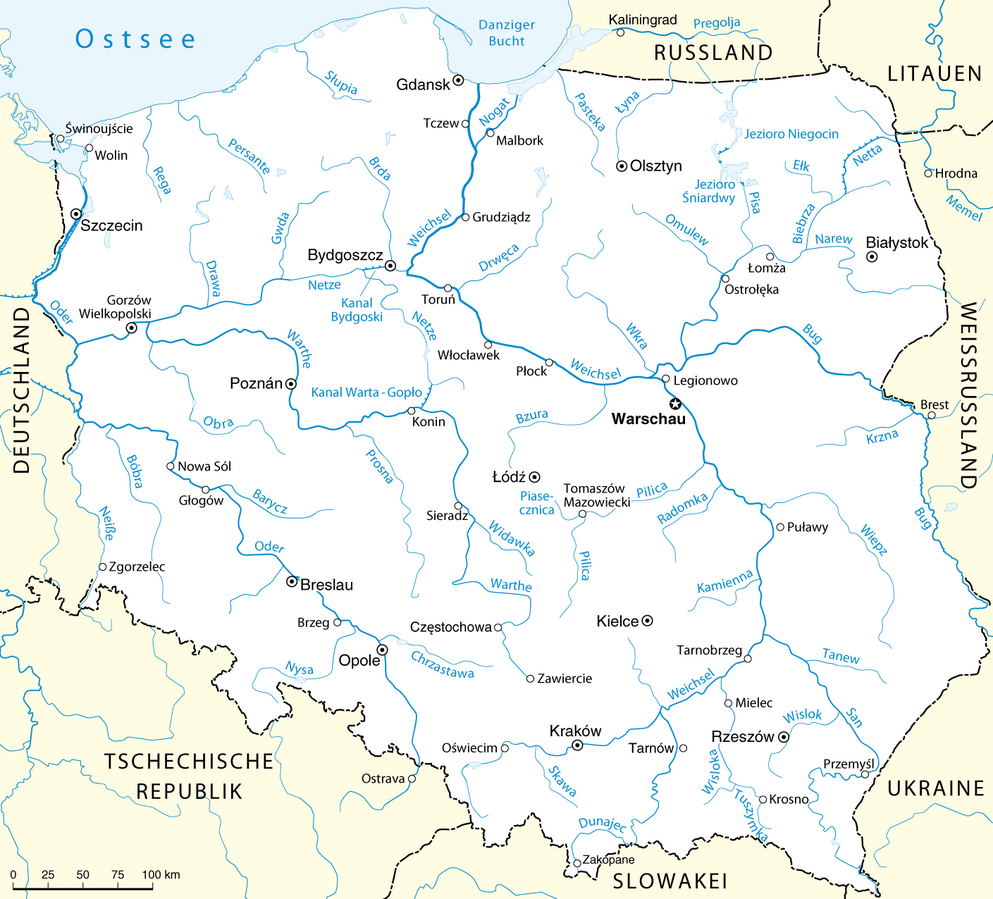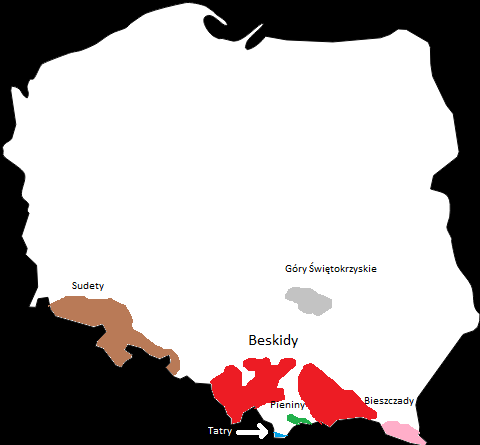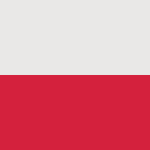Poland – location and climate
Poland is … kind of in the middle of it all. Poland is the heart of Central Europe, Poland is the centre between East and West, both mentally and geographically. The country has a reputation for being flat as a pancake, allowing other countries’ armies to overrun Poland whenever they feel like it. That’s not quite right. There are plenty of mountains in Poland, and there are also rivers, which are great for stopping advancing troops.
649 km from north to south and 689 km from east to west
Poland is a big country. The distance from the northernmost to the southernmost point in Poland is 649 kilometres, which means that the day on the Baltic Sea coast in summer is almost an hour longer than on the border with Slovakia and, conversely, almost an hour shorter in winter. From the westernmost point (the border with Germany) to the easternmost point (the border with Ukraine), the distance is 689 kilometres, giving a solar time difference between these two areas of 40 minutes. Poland belongs to the same time zone as Germany, France and Spain and has daylight saving time at the same time.
Poland has the same size as Italy
In terms of area, Poland has 312,000 square kilometres, which is slightly larger than Italy. To the north, the coastline to the Baltic coast (Baltic Sea) is 788 kilometres, to the west Poland borders Germany and to the south the Czech Republic and Slovakia. The eastern neighbours are Lithuania as well as Russia, Belarus and Ukraine, the latter three of which are also the EU’s eastern border.
Examples of distances between major cities:
Gdansk – Warsaw (motorway) 346 km
Warsaw – Krakow 292 km
Krakow – Szczecin (motorway) 649 km
Szczecin – Gdansk 369 km
Poznan – Warsaw (motorway) 311 km
Warsaw – Białystok 198 km
Typography – Poland is flat! But not everywhere.
As mentioned in the introduction, Poland is a flat country, which has benefited many armies over the years. However, this doesn’t mean that Poland is flat as a pancake; once you get away from the coastlines, you’ll see hills and valleys, and the country rises significantly above sea level. However, 90% of the area is below 300 metres above sea level. Along the coastline, sandy beaches alternate with steep cliffs. The area east of Gdansk is characterised by protected nature parks as well as large lakes and marshland, making it a paradise for yachtsmen. Poland also offers extensive natural forest areas with hunting opportunities. Southern Poland is predominantly highland with winter skiing opportunities. Poland’s highest point – Rysy (2499 metres above sea level) is located in the Carpathian Mountains, close to the border with Slovakia.
Although city breaks are becoming more and more common, the traditional form of holiday is still popular in Poland – going to the sea or mountains, or holidaying by a lake.
The sea – a gret place in Poland, and ther eis a lot of it!
If you draw a few straight lines along the coastline, you come to 440 kilometres along the Baltic Sea, but as the coastline snakes around to form seaweed, the total coastline is 788 kilometres. The sea can be found all along the Baltic Sea coast and it provides a nice, fresh breath of air when coming from the inland parts of Poland. Further east are a number of small holiday villages – Mikoszewo, Jantar, Stegna and Sztutowo in scenic surroundings. Still undiscovered by Western tourists, they are also somewhat cheaper than most other beach areas. In addition to traditional holiday entertainment, you’ll meet seals and have the opportunity to visit the Nazi concentration camp, Stutthof.
Next stops are Gdansk, Sopot and Gdynia, which offer it all. Here you’ll find city breaks, culture, medieval times, white sandy beaches and forests. North of Gdansk is the old Kashubian region, where many inhabitants speak a language that differs from Polish. Here, towns such as Rewa, Puck, Władysłowo and the Hel peninsula are fantastic and popular places to visit in the summer, and the town of Hel in particular is considered exclusive. Inland, there are huge areas of forest. If you’re in the Gdansk area and want to see Hel, the easiest way is by ferry from Gdansk, Sopot or Gdynia, but you can also take the train or drive
Coast line – small towns with castles and historical land marks
The stretch from Hel to Gdansk is full of small towns that become holiday centres in the summer. Special mention should be made of Ustka, Darłowo, Kołobrzeg and Świnoujście. Most offer hot tubs, massages and various forms of exercise and relaxation, and many of them are old fishing villages where the atmosphere has been preserved. Here you can also meet the Danish King Erik of Pomerania (1396-1439), who was adopted by Magrethe I and later became King of Denmark, Norway and Sweden before being deposed. He was originally from a Pomeranian princely family and is buried in Darłowo. If you’re based around Świnoujście, Szczecin is not too far away, offering both city breaks and perfect entertainment options for families with children. From Świnoujście there is a ferry connection to Sweden, and from several of the towns there are summer ferry connections to Bornholm.
Poland by boat – try sailing in the cnal system!
Of course, all the towns along the Baltic Sea coast offer excellent opportunities for yachtsmen. What might be interesting is the possibility of canal sailing deep inland, often in exciting lock systems.
Lakes and rivers – even inland you will find a beach
There’s plenty of water in Poland. In addition to 9,300 lakes over 1 hectare in size (100 x 100 metres equals 1 hectare), Poland is dominated by the Vistula and Oder rivers, both of which cut through the country from south to north. The Vistula runs through Krakow and Warsaw and flows into the Baltic Sea at Gdansk. The Oder River comes from the Czech Republic and runs through Opole and Wroclaw, forming a border with Germany in the northern part of Poland before flowing into the Baltic Sea at Szczecin.

Polish rivers, powered by https://commons.wikimedia.org/wiki/File:Fl%C3%BCsse_in_Polen_(Karte).png?uselang=pl
The rivers branch off, creating lots of tributaries, and you’ll find plenty of small ponds around. Some rivers also join the Vistula or the Oder, providing them with fresh water for their onward journey. The regulation of rivers and streams in Poland has been very limited, and apart from a few dikes around the major cities, the rivers can be characterised as wild rivers. This results in a little flooding every now and then, often to the surprise of those who have persuaded the local mayor to grant them a building permit in the zones marked as flood-prone. On the other hand, there are far more frogs, storks and other wildlife than in places, where nature is more controlled. High tides usually occur when the winter snow melts around March, and again in June-July when it rains heavily in the mountains.
The main roads of the past – the rivers created Poland as a super power
The natural river network is very well developed, and was used extensively in ancient times for transport, especially of agricultural products, which could be shipped from the harbour towns in the Baltic Sea. As a transport network, rivers have lost their importance, but they remain popular as recreational areas and the flowing water brings a breath of fresh air to cities.
Holiday by a lake – go to Masuria!
When Poles want to holiday by lakes, they often head to Masuria, east of Gdansk, where there’s a high probability that it will end up in a lake if you accidentally throw a stone with full force. It’s an idyllic area with lots of nature and forests, so if you’re looking for a place to contemplate life, this is it, with plenty of small guesthouses, good hotels and small houses for rent.
30% of Poland consist forest
There’s always a forest nearby when you’re in Poland, and the location of trees is usually not planned in an office, often not even registered. In other words, like so many other things, the forest in Poland is allowed to develop as best it can, and that doesn’t actually make it worse. Around 30% of Poland’s land area is covered by forest, the vast majority of which is dominated by pine. There are also a number of different spruce trees as well as some oak and beech. Forests are not only scattered around the country, but are also often found around major cities.
Up near the border with Ukraine, Europe’s only primeval forest, Puszcze Bialowieski, is untouched by foresters and home to a large and varied animal population, including bison, wolves and lynx.
Hunting – Poland is the place to go
There are plenty of opportunities for hunting in Poland, and it’s all relatively well organised with very specific rules that I wouldn’t recommend breaking. There are large amounts of wild boar, roe deer and deer. A number of agencies organise hunting trips to Poland, and it would probably be very bureaucratic if you try to apply for permits yourself. Please note that the rules are constantly changing, so even if you have hunted in Poland before, you cannot assume that the rules will remain the same.
Mountains – Poles spend their holiday by the sea or in the mountains
The mountains in Poland are located in the south and towards the borders of Germany, the Czech Republic and Slovakia, and the Świętokrzyskie Mountains are located more centrally in Poland around Kielce, where the highest point is 614 metres above sea level.
The most significant of the other mountain ranges is the Carpathian Mountains, which spread across Central Europe in a 1500 kilometre arc. It includes the Bieszczady Mountains, the Carpathian Mountains and the Tatra Mountains on the border with the Czech Republic, where the most famous holiday resort is Zakopane. The highest point on the Polish side is “Rysy”, which is over 2500 metres above sea level. If a Pole earns a lot of money, he lives in certain areas of Warsaw and meets his neighbours in winter in Zakopane and in summer in Sopot. The area is popular for both ski jumping and hiking. There is a rich wildlife with brown bears that rarely bother to talk to humans. You’ll also find snakes, salamanders and other characteristic mountain animals.

Further west is the Sudetes, where the Oder River originates. Again, the area is popular for hiking from the towns of Karpacz and Szklarska Poreba. The largest city in the area is Jelenia Góra, which is scenically located in the middle of a mountainous area.
Finally, of course, there are large, beautiful hills all around – such as Gubałówka near Szczecin, which towers 108 metres above sea level and is a popular ski resort in winter.
Climate and weather in Poland
The climate in Poland is predominantly temperate continental and can fluctuate drastically within a short period of time. The annual average temperature is around 9°C in south-west Poland, 6°C in the north-east and 4°C in the mountains. January is the coldest month with an average mean temperature of -3°C. The warmest month – July – has an average temperature of 17°C. The annual number of days with daily frost varies from 25 on the coast, over 60 in eastern Poland, to 130 in the mountains.
Large temperature differences
So much for the statistics; winters vary wildly, some years are mild and pleasantly above freezing almost all winter, other years winter coats are brought out in November, and ear warmers and scarves become a regular addition, especially in January and February, when temperatures can sometimes reach minus 40 degrees. Winter is definitely milder by the Baltics, where the sea helps keep the temperature tolerable. As indicated in the statistics, the mountain regions have many frosty days, and there is usually an adequate amount of snow for winter sports for most of the winter months.
Conversely, it can get very hot inland during the summer months, while it’s slightly cooler on the coasts. Many offices and hotels are air-conditioned, so if you’re in and out of the office a lot, it’s the ideal conditions to save yourself a cold.
6 seasons – Poland adds pre-spring and pre-winter
Traditionally, the year in Poland is divided into 6 seasons. The dates vary slightly depending on where you are in the country, but for Warsaw, the following dates are considered “official”, though of course they vary from year to year:
Weather in Poland
Pre-Spring From 10/3 (daytime temperature 0-5 C.)
Spring From 7/4 (daytime temperature 5-15 C.)
Summer From 29/5 (daytime temperature above 15 C.)
Autumn From 25/8 (daytime temperature 5-15 C.)
Pre-winter from 1/11 (daytime temperature 0-5 C.)
Winter From 25/11 (daytime temperature below freezing)
The population – Poland is receiving new immigrants
Poland’s population is 38.5 million. Until a few years ago, 98% were ethnic Poles, but Poland has become a country of immigrants. The largest group is Ukrainians and number 2 is Belarusians. These are people who are linguistically and mentally so close to Poles that they quickly assimilate into society. But there have also been many immigrants from the rest of the globe, especially to the big cities that are hungry for labour. It’s difficult to give an exact figure, but up to 10% of the population is probably currently made up of immigrants, of which around 75% are Ukrainians and Belarusians. Many of these are women and children who may return to Ukraine if their husbands and fathers return from war.
The population density is around 60% of that of Germany or the UK, but more less the same as the rest of Central Europe – 131/ km2. 60% of the population lives in urban centres and 40% in the countryside, making Poland one of the countries in Europe with the highest percentage of rural dwellers. The largest cities are (population in brackets):
How big are the towns?
Warsaw (1.860.000)
Krakow (804.000)
Wroclaw (672.000)
Lodz (670.000)
Gdansk (486.000)
Poznan (546.000)
Szczecin (396.000)
Greater Warsaw and other agglomerations
Gdansk is often considered a region (trojmiasto) along with the neighbouring cities of Sopot and Gdynia. These three municipalities are home to a total of 750,000 inhabitants. So do the cities around Katowice, which together form the Gornoslask agglomeration with 2,100,000 inhabitants. Greater Warsaw – i.e. Warsaw and surrounding cities has 3,100,000 inhabitants.
Please send an email to m@hardenfelt.pl if you would like a English-speaking tour guide to show you the most important places in Warsaw.

